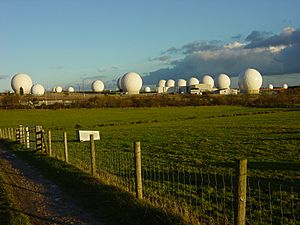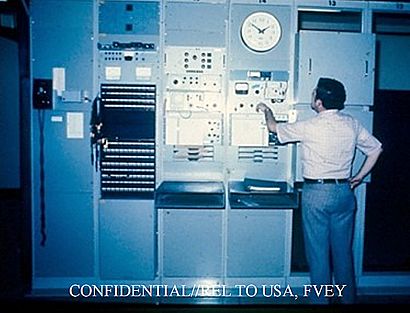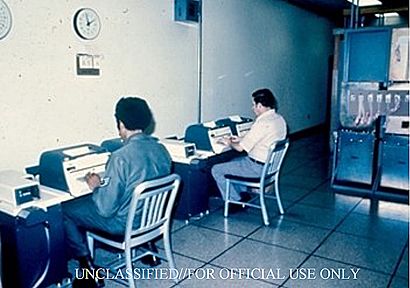ECHELON facts for kids
ECHELON, originally a secret government code name, is a special program that collects and analyzes signals intelligence (SIGINT). It's run by five countries that signed the UKUSA Agreement: Australia, Canada, New Zealand, the United Kingdom, and the United States. These countries are often called the Five Eyes.
This program started in the late 1960s. Its main goal was to listen in on military and diplomatic messages from the Soviet Union and its allies during the Cold War. ECHELON officially began in 1971. By the end of the 20th century, the ECHELON system had grown much larger.
Contents
How ECHELON is Organized

The Five Eyes intelligence group includes the main signals intelligence agencies from each member country. The European Parliament looked into this in 2000 and listed them:
- The Government Communications Headquarters (GCHQ) from the United Kingdom.
- The National Security Agency (NSA) from the United States.
- The Communications Security Establishment (CSE) from Canada.
- The Australian Signals Directorate (ASD) from Australia.
- The Government Communications Security Bureau (GCSB) from New Zealand.
These agencies work together to operate listening stations around the world. Here are some of the places where these stations are located, according to documents shared by Edward Snowden:
| Operated by the United States | |||
|---|---|---|---|
| Country | Location | Operator(s) | Codename |
| Brasília, Federal District | SCS | ||
| Bad Aibling, Bavaria |
|
GARLICK | |
| New Delhi | SCS | ||
| Misawa, Tōhoku region | LADYLOVE | ||
| Bangkok (?) | LEMONWOOD | ||
| Menwith Hill, Harrogate | MOONPENNY | ||
| Sugar Grove, West Virginia | TIMBERLINE | ||
| Yakima, Washington | JACKKNIFE | ||
| Sábana Seca, Puerto Rico | CORALINE | ||
| Operated Jointly with the United States (2nd party) | |||
| Country | Location | Contributor(s) | Codename |
| Geraldton, WA | STELLAR | ||
| Darwin, NT | SHOAL BAY | ||
| Waihopai, Blenheim | IRONSAND | ||
| Bude, Cornwall | CARBOY | ||
| Ayios Nikolaos Station | SOUNDER | ||
| Nairobi | SCAPEL | ||
| Seeb, Muscat | SNICK | ||
How ECHELON Was Revealed
Early Disclosures (1972–2000)
The first person to talk about ECHELON publicly was a former NSA analyst named Perry Fellwock in 1972. He used a fake name, Winslow Peck, and told a magazine about a worldwide network of listening posts.
In 1982, journalist James Bamford wrote a book called The Puzzle Palace. It looked closely at the NSA, which was a very secret agency back then. He wrote about a huge listening operation called "SHAMROCK," which was an earlier name for ECHELON before 1975.
In 1988, Margaret Newsham, who worked for a company under contract with the NSA, told members of the US Congress about the ECHELON system. She said that phone calls of a US senator were being collected. Investigators found that listening to US political figures was part of the system's design.
Also in 1988, journalist Duncan Campbell wrote an article describing ECHELON as a program that collected signals intelligence. He said it was software that controlled how civilian communications from satellites were gathered and shared.
A detailed description of ECHELON came from New Zealand journalist Nicky Hager in his 1996 book Secret Power: New Zealand's Role in the International Spy Network. This book was later mentioned by the European Parliament in a report.
In 1999, the Australian government officially admitted that news reports about the secret UKUSA Agreement were true. They said their Defence Signals Directorate (now ASD) worked with other signals intelligence groups under the UKUSA relationship.
In 2000, James Woolsey, a former head of the US Central Intelligence Agency, confirmed that US intelligence uses systems to listen in and search for keywords to monitor businesses in Europe.
Some lawmakers in the United States worried that ECHELON could be used to spy on US citizens. The New York Times said that ECHELON was so secret that it was hard to prove it even existed. Critics called it a "Big Brother without a cause" after the Cold War ended.
European Parliament Investigation (2000–2001)
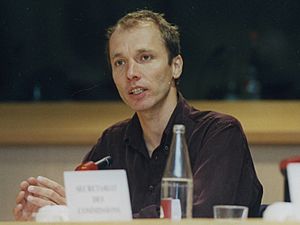
A group from the European Parliament investigated ECHELON's abilities and effects in 2000 and 2001. They published a report in 2001. In July 2000, the Temporary Committee on the ECHELON Interception System was created to look into the spy network.
In May 2001, as the committee was finishing its report, a group traveled to Washington, D.C., to meet with US officials. However, all their meetings were canceled by the US government, and the committee had to leave early. A BBC reporter said in May 2001 that "The US Government still refuses to admit that Echelon even exists."
In July 2001, the Committee released its final report. They concluded that ECHELON was likely a way to sort collected signals, rather than a full analysis tool. The European Parliament voted to accept the report on September 5, 2001.
The report stated that ECHELON was a system for collecting signals intelligence. It could intercept and check the content of phone calls, faxes, emails, and other data traffic worldwide. This was done by listening to satellite transmissions, public phone networks (which used to carry most internet traffic), and microwave links.
ECHELON Confirmed (2015)
In 2015, two internal NSA newsletters from 2011 and 2012 were published as part of Edward Snowden's leaks. These documents confirmed for the first time that the NSA used the code word ECHELON. They also gave some details about the program. ECHELON was part of a larger program called FROSTING, started by the NSA in 1966 to collect and process data from communication satellites. FROSTING had two parts:
- TRANSIENT: for intercepting Soviet satellite transmissions.
- ECHELON: for intercepting Intelsat satellite transmissions.
The European Parliament's committee said it was "likely" that the name was ECHELON, based on all the evidence.
Former NSA employee Margaret Newsham said she worked on setting up the ECHELON computer network from 1974 to 1984. She said ECHELON was the NSA's name for the computer network itself.
Britain's The Guardian newspaper described ECHELON's abilities: it was a global network of electronic spy stations that could listen to phones, faxes, and computers. It could even track bank accounts and store millions of records on people. But officially, it didn't exist.
Documents leaked by Edward Snowden also showed that ECHELON's collection of satellite data is also called FORNSAT, which means "Foreign Satellite Collection."
Intercept Stations

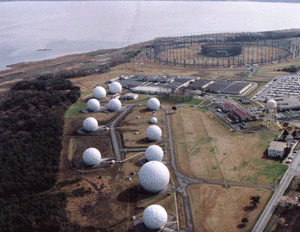
Reports from the European Parliament and later Edward Snowden's leaks revealed that the following ground stations have been involved in intercepting communications:
- RAF Little Sai Wan (Closed) (Hong Kong) Map
- Australian Defence Satellite Communications Station (Geraldton, Western Australia) Map
- RAF Menwith Hill (Yorkshire, England – Largest known ECHELON facility) Map
- Misawa Security Operations Center (Oura, Misawa, Aomori, Tōhoku, Japan) Map
- GCHQ Bude (formerly CSO Morwenstow) (Cornwall, UK) Map
- Pine Gap (Outside Alice Springs, Northern Territory, Australia) Map
- Sugar Grove (Closed) (West Virginia, US) Map
- Yakima Training Center (Closed) (Washington State, US) Map
- Buckley Space Force Base (Aurora, Colorado) Map
- GCSB Waihopai (Marlborough, New Zealand) Map
- GCSB Tangimoana (Manawatu-Wanganui, New Zealand) Map
- CFS Leitrim (Ottawa, Ontario, Canada) Map
- Teufelsberg (Closed 1992), Berlin, Germany – Used to listen to the Eastern Bloc.) Map
- Ayios Nikolaos (British Sovereign Base area of Dhekelia, Cyprus)
- Gibraltar (UK)
- Diego Garcia (UK)
- Bad Aibling Station (Bad Aibling, Germany – US)
- relocated to Griesheim/Darmstadt in 2004.
- Fort Gordon (Georgia, US)
- CFB Gander (Newfoundland and Labrador, Canada)
- Guam (Pacific Ocean, US)
- Kunia Regional SIGINT Operations Center (Hawaii, US)
- Lackland Air Force Base, Medina Annex (San Antonio, Texas, US)
- RAF Edzell (Closed 1996) (Scotland)
- RAF Boulmer (England)
- SNICK International Processing Center (Seeb, Oman) Map
History of ECHELON
Being able to intercept communications depends on how the messages are sent, whether by radio, satellite, microwave, cell phone, or fiber-optic cable. During World War II and the 1950s, high-frequency radio was common for military and diplomatic talks and could be intercepted from far away.
When geostationary communications satellites started appearing in the 1960s, they opened new ways to intercept international communications. In 1964, plans for the ECHELON network began after many countries agreed to create International Telecommunications Satellite Organization (Intelsat), which would own and operate a global group of satellites.
The first Intelsat satellite was launched in 1966. From 1970 to 1971, the Government Communications Headquarters (GCHQ) in Britain started a secret signal station at Morwenstow, England. This station intercepted satellite communications over the Atlantic Ocean and Indian Oceans. Soon after, the US National Security Agency (NSA) built another station at Yakima, near Seattle, to intercept satellite communications over the Pacific Ocean.
In 1981, GCHQ and the NSA began building the first global wide area network (WAN). Australia, Canada, and New Zealand soon joined the ECHELON system. A 2001 report to the European Parliament stated that if the UKUSA countries have listening stations in the right places, they can, in theory, intercept all phone, fax, and data traffic sent via satellites.
Most reports on ECHELON focus on satellite interception. However, information given to the European Parliament suggested that similar systems are used by the UKUSA countries to monitor communications through undersea cables, microwave transmissions, and other lines.
Today, most long-distance voice and data traffic travels through optical-fiber cables, not satellites. By 2006, 99% of the world's long-distance communication used fiber optics. This means that most communications can no longer be intercepted by ground stations that listen to satellites. Instead, they can only be collected by tapping into cables or intercepting microwave signals, which is much harder to do widely.
Concerns About ECHELON
Journalists Duncan Campbell and Nicky Hager said in the 1990s that the United States was using ECHELON to gain business secrets, not just for military or diplomatic reasons. This is known as industrial espionage.
In 2001, the European Parliament's committee suggested that people in member countries should use cryptography (secret codes) in their communications to protect their privacy. This was because they believed that US intelligence agencies had used ECHELON for economic spying.
American author James Bamford offered a different view. He pointed out that laws usually prevent the use of intercepted communications for business purposes.
The European Parliament's committee clearly stated in its report that the ECHELON network was used to intercept private and business communications, not just military ones. The committee quoted a famous saying, "Sed quis custodiet ipsos custodes" ("But who will watch the watchers"). James Bamford warned in 2001 that if ECHELON continued without checks, it could become a "cyber secret police, without courts, juries, or the right to a defence."
Here are some examples of alleged spying by the "Five Eyes" countries:
- In 1983, the Canadian Communications Security Establishment supposedly spied on two British government ministers for the British Prime Minister Margaret Thatcher.
- The US National Security Agency listened to the phone calls of Diana, Princess of Wales until she died in 1997. The NSA has many secret documents about her. Officials said that any mentions of Diana in intercepted calls were accidental, and she was not a target.
- UK agents monitored conversations of Kofi Annan, who was the 7th Secretary-General of the United Nations.
- US agents collected detailed information on Ban Ki-Moon, the 8th Secretary-General of the United Nations.
- In the early 1990s, the US National Security Agency intercepted communications between the European aerospace company Airbus and the Saudi Arabian national airline. In 1994, Airbus lost a big contract with Saudi Arabia. This happened after the NSA reportedly shared information that Airbus officials were trying to bribe Saudi officials. As a result, the American company McDonnell Douglas (now part of Boeing) won the contract instead.
- The US defense company Raytheon won a large contract with the Brazilian government to monitor the Amazon rainforest. This happened after the US Central Intelligence Agency (CIA) reportedly shared information that Raytheon's French competitor, Thomson-Alcatel, had been paying bribes to get the contract.
- In 1995, the CIA listened to conversations between Japanese government officials and car company executives from Toyota and Nissan. This was done to help the United States in trade talks with the Japanese Trade Minister.
How ECHELON Works

TOPCO = Terminal Operations Control
CCS = Computer Control Subsystem
STEAMS = System Test, Evaluation, Analysis, and Monitoring Subsystem
SPS = Signal Processing Subsystem
TTDM = Teletype Demodulator
The first US ground station for the ECHELON program was built in 1971 near Yakima, Washington. This facility, code-named JACKKNIFE, cost about $21.3 million and had around 90 people. It intercepted satellite traffic using a large 30-meter dish antenna. The station started working fully on October 4, 1974.
In 1999, Professor Desmond Ball told the Australian Senate that the Pine Gap facility was used to intercept communications from satellites. These satellites were said to have large radio dishes, between 20 and 100 meters wide, in orbits that stay above the same spot on Earth. The original goal was to monitor messages from Soviet weapons, air defense systems, and other radars, as well as transmissions from satellite ground stations and ground-based microwave communications.
Examples of Business Spying
In 1999, Enercon, a German company that makes wind energy equipment, developed a new generator for wind turbines. After applying for a US patent, they found that an American rival, Kenetech, had submitted a very similar patent application shortly before. A former NSA employee later claimed that the NSA had secretly listened to Enercon's data communications and conference calls and shared information about the new generator with Kenetech. However, later German news reports said this story was incorrect, as the American patent was filed three years before the alleged spying happened.
German intelligence services are not allowed to do business spying. German companies have complained that this leaves them unprotected against business spying from countries like the United States or Russia. According to a former manager at Bayer, a German company, German intelligence services know which companies are being targeted by US intelligence agencies but do not tell the companies.
See also
- Global surveillance disclosures (2013–present)
- ADVISE
- Frenchelon
- List of government surveillance projects
- Mass surveillance
- Onyx (interception system), the Swiss "Echelon"
- Operation Ivy Bells


